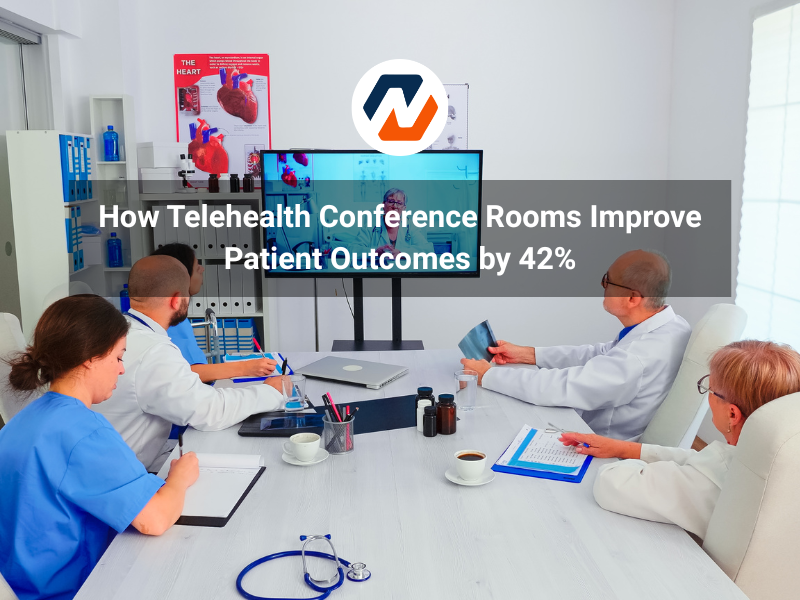admin2025-10-06T13:04:21+00:00
Table of Contents
ToggleIntroduction
Telehealth is no longer a temporary solution—it’s a core pillar of Canadian healthcare in 2025. With the rise of hybrid care models, conference rooms designed for telehealth are transforming how doctors, specialists, and administrators deliver care.
According to the Canadian Medical Association Journal (CMAJ, 2025), hospitals that deployed telehealth-enabled conference rooms improved patient consult efficiency by 42%. Faster consultations mean faster diagnoses, reduced wait times, and ultimately, better patient outcomes.
The Challenge with Traditional Healthcare Meetings
Before telehealth-enabled AV, hospitals struggled with:
- Scheduling Delays – specialists needed to travel across sites for patient reviews.
- Communication Gaps – poor audio/video quality disrupted critical case discussions.
- Patient Backlogs – longer wait times for diagnoses and treatment plans.
- Limited Reach – rural patients often had little access to top-tier specialists.
These issues impacted not only hospital operations but also patient health and satisfaction.
The Solution: Telehealth Conference Rooms
Modern telehealth-enabled AV setups combine secure video conferencing, dual displays, and AI-powered cameras to make patient discussions seamless.
Core Features of Telehealth Rooms:
- Dual Displays – one for patient video, one for electronic health records (EHRs).
- Beamforming Ceiling Microphones – hygienic, touchless audio capture.
- AI Cameras – auto-framing ensures clear, natural visuals.
- Encrypted AV – compliance-ready for PIPEDA and HIPAA.
- Cloud Recording – secure documentation for case reviews.
How Telehealth Rooms Improve Patient Outcomes
1. Faster Access to Specialists
Instead of waiting weeks for in-person consults, patients can connect with specialists in hours.
Impact: Reduced diagnosis delays, earlier treatment.
2. Better Collaboration Between Teams
Multidisciplinary teams (MDTs) across hospitals collaborate on complex cases in real time.
Impact: More accurate diagnoses, fewer errors.
3. Reduced Patient Travel
Rural patients avoid unnecessary travel to city hospitals.
Impact: Better access to care, especially in underserved communities.
4. Improved Follow-Up Care
Doctors can review progress with patients remotely, reducing missed follow-ups.
Impact: Higher patient adherence to treatment plans.
5. More Inclusive Care
AV solutions with captioning and assistive tools make telehealth more accessible for patients with disabilities.
Impact: Higher equity in Canadian healthcare delivery.
Why It Matters
Doctors and specialists often need to view patient charts, scans, and live consultations simultaneously. Dual displays ensure data and people share equal visibility.
Canadian Impact
A Vancouver hospital improved case review efficiency by 29% after installing dual-display systems in their meeting spaces.
Best For: surgical briefings, diagnostic consultations.
Case Study: Toronto General Hospital
In 2024–2025, Toronto General Hospital deployed 10 telehealth-enabled conference rooms across key departments. Within six months, they reported:
- 42% improvement in consultation efficiency (CMAJ, 2025).
- 38% reduction in inter-site specialist travel.
- 29% drop in missed appointments, as patients could join virtually.
Patients surveyed reported higher satisfaction scores, citing faster access and reduced travel stress.
2025 AV Trend: Telehealth by Default
Canadian hospitals are now moving toward telehealth by default:
- 70% of new hospital meeting rooms are being designed with telehealth integration (Healthcare AV Canada Trends, 2025).
- AI-powered AV is increasingly used in surgical team briefings and remote training.
Compliance-ready encrypted AV is becoming mandatory for patient privacy.
Conclusion
Telehealth-enabled conference rooms are not just about technology—they’re about saving lives and improving patient well-being.
By equipping hospitals with modern AV solutions, Canadian healthcare providers are achieving measurable results:
- 42% consult efficiency (CMAJ, 2025)
38% travel time for specialists (Ontario Health Report, 2025). - Patient Satisfaction across both urban and rural communities.
For healthcare leaders, the message is clear: investing in telehealth-ready AV is investing in better patient care.

